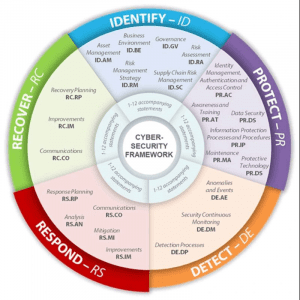 The NIST Cybersecurity Framework (CSF) stands as a cornerstone in the ongoing battle to secure our digital landscape. In today’s interconnected and data-centric world, safeguarding sensitive information and shielding organizations from cyber threats is paramount.
The NIST Cybersecurity Framework (CSF) stands as a cornerstone in the ongoing battle to secure our digital landscape. In today’s interconnected and data-centric world, safeguarding sensitive information and shielding organizations from cyber threats is paramount.
At its core, the NIST CSF offers a comprehensive and adaptable approach to managing cybersecurity risks. It provides essential principles, best practices, and guidelines that empower organizations of all sizes and sectors to safeguard critical assets and bolster their overall cybersecurity readiness.
Let’s delve into the framework’s fundamental components:
1️⃣ Identify: This initial stage revolves around recognizing an organization’s most valuable assets, such as customer data, intellectual property, and financial records. By understanding what needs protection, organizations can strategically prioritize their security efforts.
2️⃣ Protect: In this phase, implementing safeguards, preventive measures, and security controls is crucial. Activities like access control, employee awareness training, and encryption are key components, helping mitigate potential risks and vulnerabilities effectively.
3️⃣ Detect: Given the ever-evolving nature of cyber threats, it’s vital to establish mechanisms for promptly identifying and detecting potential incidents. Investments in advanced monitoring systems, boundary protection, and intrusion detection tools empower organizations to respond swiftly and effectively.
4️⃣ Respond: In the unfortunate event of an incident, having an organized and well-defined response plan is critical. This stage involves establishing communication protocols, incident reporting guidelines, and threat mitigation strategies to minimize damages and reduce downtime.
5️⃣ Recover: Following an incident, the focus shifts to restoring an organization’s systems, data, and processes to normalcy. Incorporating recovery strategies, backups, and continuous monitoring aids in bouncing back stronger and gleaning valuable insights from the experience.
By embracing the NIST Cybersecurity Framework, organizations can:
✅ Foster Common Language: The framework enables the creation of a shared vocabulary around cybersecurity, fostering better collaboration between IT departments and executives.
✅ Assess and Improve: Organizations can assess their current security posture, identifying areas for enhancement and improvement.
✅ Enhance Communication: Clear communication of security efforts to clients, partners, and stakeholders builds trust and credibility.
✅ Strategic Alignment: The framework helps organizations prioritize resources, focus investments, and align cybersecurity initiatives with overall business objectives.
However, it’s essential to recognize that cybersecurity is not a one-time event. Regular updates, reviews, and continuous improvement are imperative to stay ahead of emerging threats and maintain a robust security posture. Stay vigilant, stay updated, and stay secure.
Explore a wealth of information on our website https://www.hammett-tech.com/our-blog/
Visit our Socials!

